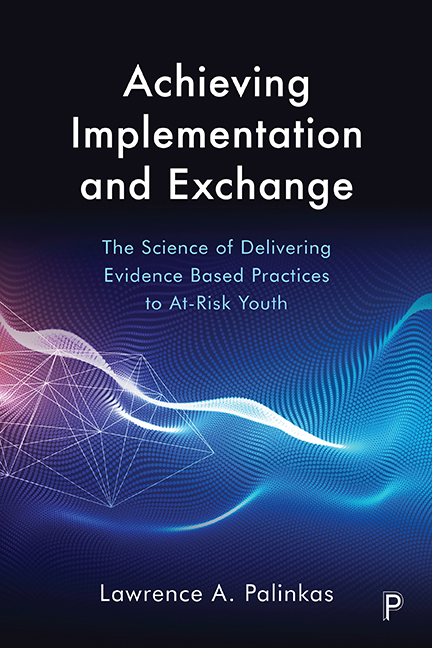 Achieving Implementation and Exchange
Achieving Implementation and Exchange Book contents
- Frontmatter
- Dedication
- Contents
- Tables and figures
- Abbreviations
- Preface
- 1 Introduction
- 2 The need for evidence-based practice
- 3 Understanding and reducing the gap
- 4 EBP implementation in child welfare and child mental health
- 5 Social networks and EBP implementation
- 6 Use of research evidence and EBP implementation
- 7 Local models of EBP implementation
- 8 Research–practice–policy partnerships
- 9 Cultural exchange and EBP implementation
- 10 A transactional model of implementing EBP
- References
- Index
6 - Use of research evidence and EBP implementation
Published online by Cambridge University Press: 13 April 2022
- Frontmatter
- Dedication
- Contents
- Tables and figures
- Abbreviations
- Preface
- 1 Introduction
- 2 The need for evidence-based practice
- 3 Understanding and reducing the gap
- 4 EBP implementation in child welfare and child mental health
- 5 Social networks and EBP implementation
- 6 Use of research evidence and EBP implementation
- 7 Local models of EBP implementation
- 8 Research–practice–policy partnerships
- 9 Cultural exchange and EBP implementation
- 10 A transactional model of implementing EBP
- References
- Index
Summary
Family Functional Therapy is the evidence-based program that we had some data from the California Institute of Mental Health and also some websites that look like it was being implemented in Los Angeles County, and we had some contact with them and CIMH and we looked at the research and it looked very promising. So, we made a decision. We were pretty happy with it, the Family Functional Therapy, to move forward with this, so that's what we did. And it hasn't disappointed us…My assistant chief talked to [a CIMH staff member] pretty extensively about that and we had some discussion and several meetings with our providers here and our community-based organization. We looked at a lot of data in the Washington State Institute of Public Policy and, again, some of the websites on evidence-based programming and what works. So we reviewed a lot of literature and I can't remember all the places that we looked, they had not only analysis, but meta-analyses, that showed that if you do it with fidelity, any of these programs would work well. (Chief probation officer)
As we observed in the last chapter, social networks play an important role in the flow of information to and from network members. Much of this information occurs in the form of research evidence that is used to support the choice of an EBP by a service system as well as to provide guidance on how the EBP should be implemented. In this chapter, we examine in closer detail the process of acquiring, evaluating, and applying research evidence in EBP implementation. We draw on the experience of using research evidence to implement TFCO among county-level child welfare, child mental health and juvenile justice systems in California and Ohio and adopting EBPs and other innovative practices in New York State-supported child mental health clinics. The experience of implementation in California and Ohio enables us to examine the extent to which EBP implementation is associated with the source of evidence, how practitioners evaluate the evidence obtained, how they apply it, or ignore it, when deciding whether or not to implement, and whether this use of research evidence (URE) is associated with the implementation stage from engagement to sustainment.
- Type
- Chapter
- Information
- Achieving Implementation and ExchangeThe Science of Delivering Evidence-Based Practices to At-Risk Youth, pp. 99 - 118Publisher: Bristol University PressPrint publication year: 2018


